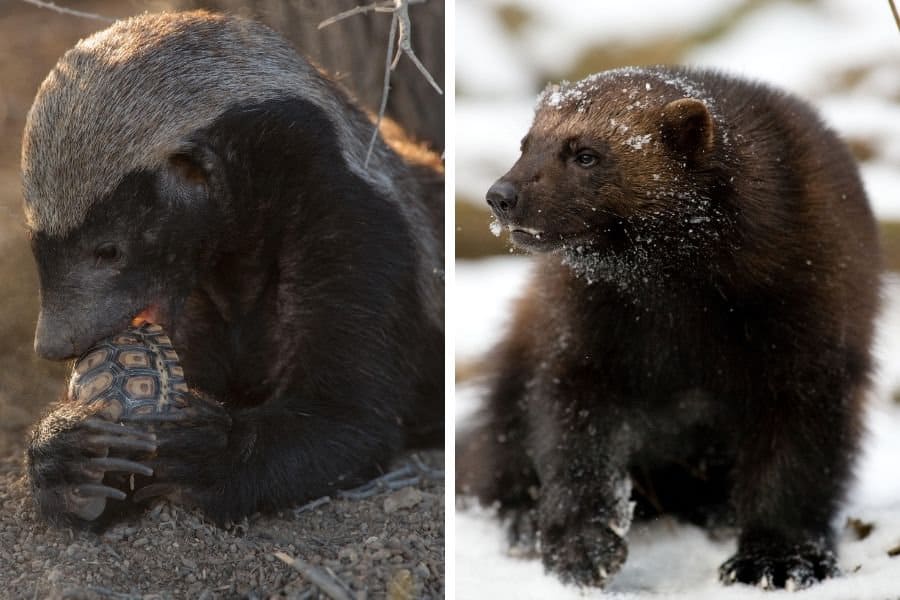Q: How badass is a honey badger?
A: Yes.
That doesn’t make much sense. Then again, neither do a lot of things written about the honey badger.
If you believe everything you read, this mighty mustelid beats up lions before breakfast and stops bullets in their tracks.
Recently, it’s even achieved internet stardom.
Maybe you’ve seen the “honey badger don’t care” memes? Perhaps you’ve seen viral videos of them chasing off lions and snacking on snakes?
There’s one common theme – honey badgers are tough.
How tough, though?
Is the honey badger a legit “badass”, a regular wild animal, or somewhere in between? Join us as we separate fact from fiction and investigate the rowdy ratel’s reputation.
What is a Honey Badger?

For starters, the honey badger isn’t closely related to its namesake. It’s basically an overgrown weasel, and the only member of the genus Mellivora.
Honey badgers, or ratels, have a wide distribution over both Sub-Saharan Africa and Asia.
While they’re not large animals, they’re known for punching above their weight. The African subspecies share their habitat with large predators like lions, leopards, and hyenas, so they need to.
How Dangerous is a Honey Badger?
Are honey badgers dangerous?
Well, that mostly depends on what kind of animal you are.
Honey badgers are voracious carnivores – their prey would certainly consider them dangerous!
Given their reasonably small size, most animals the ratel preys on are also on the smaller side. They’re not too picky, and will root out rodents, reptiles, birds, and more. They’ve also been known to attack larger livestock like sheep and goats.
Honey badgers are also fond of – you guessed it – honey. They’ll suffer several stings to get at the good stuff.
Encounters with humans
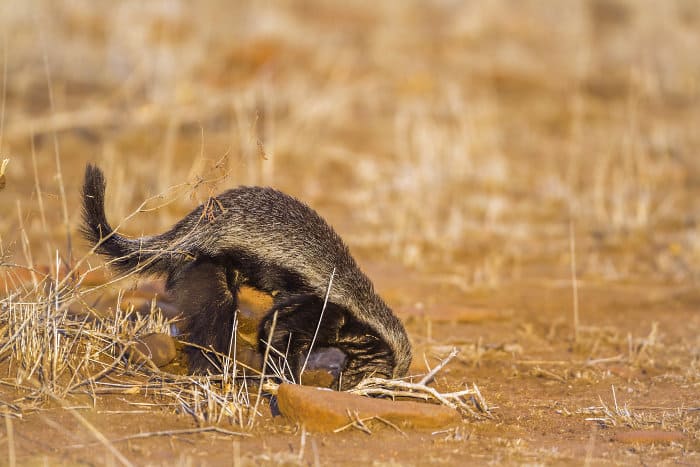
As you can probably guess, honey badgers aren’t too popular with beekeepers, or livestock owners.
Those large claws come in handy for digging prey out of burrows and breaking up bee hives, but they’re equally useful for getting past man-made defenses. Like a chicken coop, for example.
This often causes conflict with locals, and unfortunately honey badgers are considered pests and killed in many parts of Africa.
Commercial beekeepers aren’t the ratel’s biggest fans, although it’s understandable.
They can suffer huge losses if the peckish predator raids their hives. Fortunately, there are measures which can be taken to protect their business from honey badgers.
Hopefully, locals can be convinced that living with the ratel can be done with a few minor tweaks.
Do honey badgers attack humans?
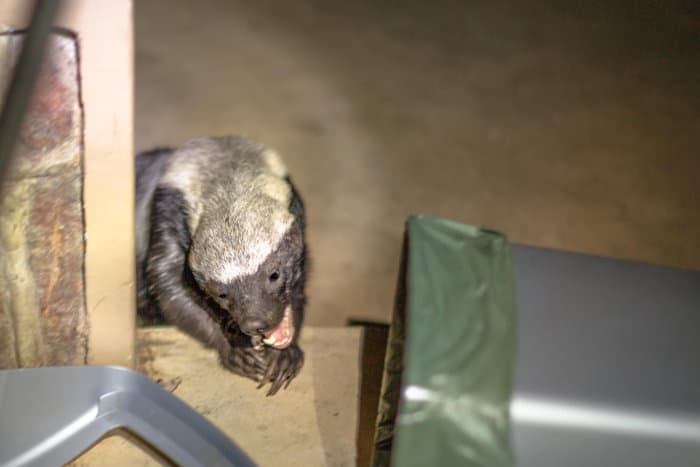
Despite their reputation for fearlessness, ratels are not the reckless creatures many people think.
In fact, they’re quite shy and elusive when it comes to human contact. Honey badgers that live close to human habitation become largely nocturnal to avoid us. Many sightings on safari are fleeting glimpses, as the ratel goes about its business.
It’s extremely unlikely a honey badger would attack unless cornered or provoked. If it feared for its safety, or you came between it and a meal, then you might have an issue. Then again, that’s true of most wild animals, especially predators.
There are anecdotal accounts of honey badgers wounding or even killing humans, but it’s hard to find evidence. They’re certainly capable of doing significant damage.
But, if honey badgers had their heart set on attacking humans, we’d see a lot more aggressive encounters.
Are Honey Badgers Bulletproof?
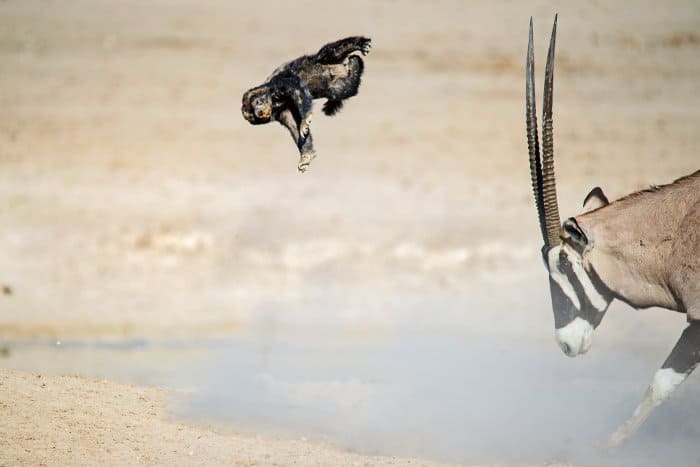
This is another claim that gets thrown around a lot. Like many myths, it has a slight basis in fact – the honey badger does have very thick skin.
In The Carnivores of West Africa by Donovan Rosevear, the author claims their skin can withstand spears, arrows, and even a machete blow.
As for bullets?
Honey badgers are tough, but not invincible.
In the same book, Rosevear says they can be killed with a club or a shot to the head.
Even if the stories are slightly exaggerated, it’s clear honey badgers are hard to kill. But then again, why would you want to?
Honey Badger vs…The World
One side-effect of the honey badger’s badass reputation? People are intrigued by its fighting abilities.
There are many tall tales about them taking on much larger predators. Let’s see if we can find out the facts.
Fighting machine
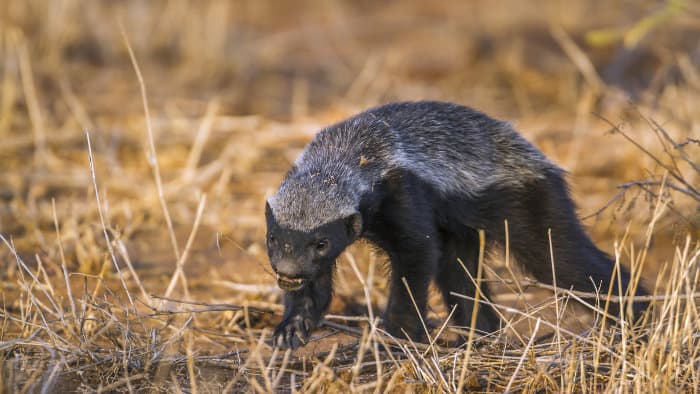
In many ways, the honey badger is built for combat, or at least self-defense. When it shares its habitat with large predators, that comes in handy.
Various physical adaptations have ensured that the ratel is hard to hurt in a fight. Its small eyes and ears are tricky targets, while its neck is protected by an especially thick layer of skin. It has serious jaw strength and a powerful frame.
Their skin is also extremely loose. This enables the ratel to twist and turn out of a predator’s grasp while defending itself.
Sometimes it won’t even come to a physical fight. The honey badger stores a revolting smelling substance in its anal pouch, which it releases in dire situations. The smell has been politely described as “suffocating.”
Groin shot specialty?
It’s sometimes said that the honey badger targets its opponent’s genitals. There’s even an account from 1947 of a honey badger reportedly castrating a buffalo.
Ratels have supposedly used this technique on wildebeest, waterbuck, kudu, zebras, and even humans, although no direct evidence supports these stories.
It’s plausible that the honey badger would target vulnerable areas. And with those sharp claws, a groin shot would cause serious issues. But the jury’s out on whether this is a common technique.
Either way, I don’t think volunteers are lining up to test it out.
Honey badger vs lion

When you’re lacking in size, you’ve got to make up for it with tenacity. That’s how honey badgers can sometimes repel even the “king of the jungle.”
Ratels have been known to fend off lions when escape is impossible. It’s not like they stroll around the savanna looking for fights, though. They’d rather steer clear of the big cats.
Pride of the lions pride taken to dust?
The honey badger is known for its strength, ferocity and toughness. It is known to savagely and fearlessly attack almost any other species when escape is impossible, reportedly even repelling much larger predators such as lion and hyena. pic.twitter.com/7iyz0hPHxN
— Susanta Nanda IFS (@susantananda3) August 6, 2020
Sometimes, their tenacity can make a lion retreat.
Not because the big cat wouldn’t win a fight, but because it wouldn’t be worth risking the ratel’s claws and jaws for little reward. And if the crotch shot is a common strategy, no lion wants a badass honey badger grabbing its gonads!
Other honey badger vs lion encounters don’t go so well. There are documented cases of lions killing ratels.
Honey badger vs snake
The honey badger vs snake match-up depends largely on the snake species. Small reptiles are regular prey for the ratel, but sometimes it bites off more than it can chew.
In one incident, caught on film in Botswana, a ratel was almost killed by a large python. With the “help” of a couple of jackals, the honey badger escaped the constrictor’s clutches and made a meal of it.
The ratel also munches on venomous snakes. But it’s not because it’s got a death wish – it’s because it has a genetic immunity to snake venom. At least, err, according to that study.
This article disagrees, suggesting immunity isn’t something they’re born with.
Pups are supposedly introduced to venomous creatures over time, until they can pop a puff adder in their mouth with few side-effects. (Though they’re sometimes stung to death by bees.)
Whichever version is true, this round definitely goes to the honey badger.
Honey badger vs wolverine
This one’s more of a hypothetical scenario, since the two wouldn’t cross paths in the wild. But the wolverine is another mustelid with a fearsome reputation, and many people are interested in a honey badger vs wolverine match-up.
The realistic answer is that these predators probably wouldn’t want anything to do with each other. Risking injury just isn’t worth it.
Things could get interesting if food were involved, though. Wolverines are nicknamed “glutton” and have been known to defend kills against wolves and bears.
If it came to a honey badger vs wolverine fight, the two animals seem very evenly matched. Wolverines are slightly larger on average, but honey badgers have the bigger claws.
It’s too close to call. It would depend on the individual animals, though the chances are neither would come out unscathed.
Honey Badger Don’t Care…About Its Bad Reputation
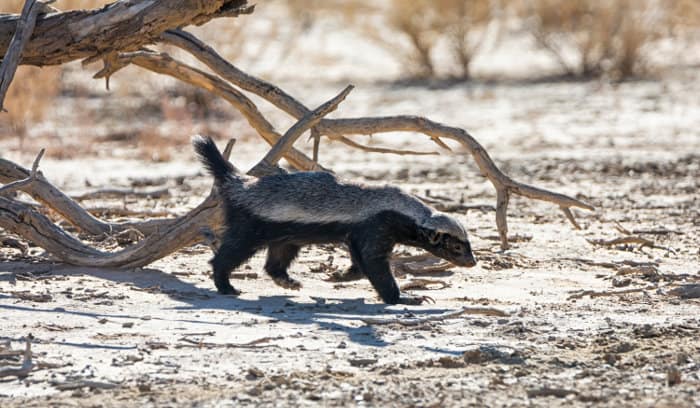
Despite their cute appearance, it’s true that these critters aren’t the cuddliest. And as we’ve seen, they’re feisty customers who won’t back down.
It’s fair to say the honey badger is “badass”, if that means brave, tough, and formidable in a fight. But it’s also true that its reputation is exaggerated.
Many claims about it are unproven and have spread around the internet as if they’re facts.
Honey badgers are like many wild animals. They’re unlikely to hold hands and sing Kumbaya with their fellow creatures. Yet, most of the time, they’re happy to be left in peace (unless they’re hunting for dinner!).
Discover the Honey Badger in Africa
While honey badgers have the tools to be dangerous, there are very few verified attacks on humans. Much of the time, they go out of their way to avoid contact with us, or large predators like lions and leopards.
If you see one on safari, you should feel lucky rather than scared. They’re elusive and often move around at night. Etosha National Park, Tsavo National Park, and Hwange National Park are well-known areas for spotting them.
Plan your dream safari here, and you could get a glimpse of the badass honey badger yourself. (Just don’t try and hug it…)



